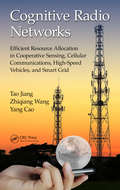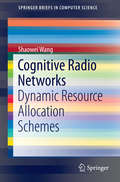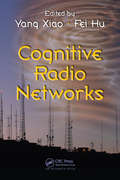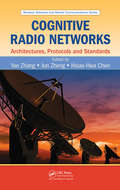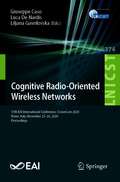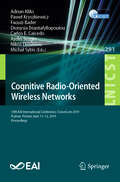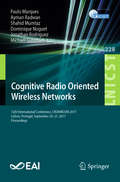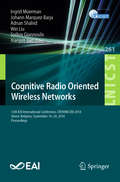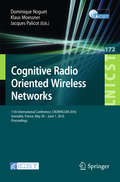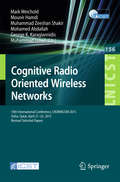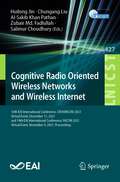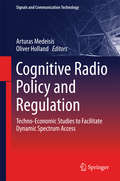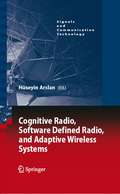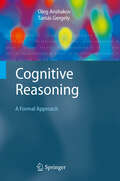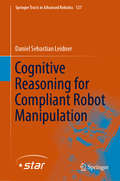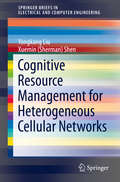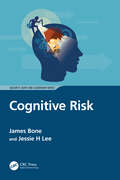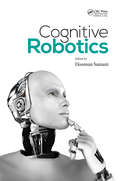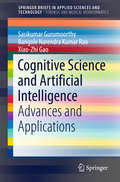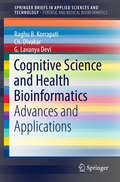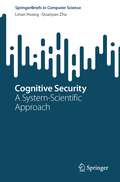- Table View
- List View
Cognitive Radio Networks: Efficient Resource Allocation in Cooperative Sensing, Cellular Communications, High-Speed Vehicles, and Smart Grid
by Tao Jiang Yang Cao Zhiqiang WangResource allocation is an important issue in wireless communication networks. In recent decades, cognitive radio-based networks have garnered increased attention and have been well studied to overcome the problem of spectrum scarcity in future wireless communication systems. Many new challenges in resource allocation appear in cognitive radio-based networks. This book focuses on effective resource allocation solutions in several important cognitive radio-based networks, including opportunistic spectrum access networks, cooperative sensing networks, cellular networks, high-speed vehicle networks, and smart grids.
Cognitive Radio Networks: Efficient Resource Allocation in Cooperative Sensing, Cellular Communications, High-Speed Vehicles, and Smart Grid
by Tao Jiang Yang Cao Zhiqiang WangResource allocation is an important issue in wireless communication networks. In recent decades, cognitive radio-based networks have garnered increased attention and have been well studied to overcome the problem of spectrum scarcity in future wireless communication systems. Many new challenges in resource allocation appear in cognitive radio-based networks. This book focuses on effective resource allocation solutions in several important cognitive radio-based networks, including opportunistic spectrum access networks, cooperative sensing networks, cellular networks, high-speed vehicle networks, and smart grids.
Cognitive Radio Networks: Dynamic Resource Allocation Schemes (SpringerBriefs in Computer Science)
by Shaowei WangThis SpringerBrief presents a survey of dynamic resource allocation schemes in Cognitive Radio (CR) Systems, focusing on the spectral-efficiency and energy-efficiency in wireless networks. It also introduces a variety of dynamic resource allocation schemes for CR networks and provides a concise introduction of the landscape of CR technology. The author covers in detail the dynamic resource allocation problem for the motivations and challenges in CR systems. The Spectral- and Energy-Efficient resource allocation schemes are comprehensively investigated, including new insights into the trade-offs for operating strategies. Promising research directions on dynamic resource management for CR and the applications in other wireless communication systems are also discussed. Cognitive Radio Networks: Dynamic Resource Allocation Schemes targets computer scientists and engineers working in wireless communications. Advanced-level students in computer science and electrical engineering will also find this brief useful reading about the next generation of wireless communication.
Cognitive Radio Networks
by Yang Xiao Fei HuFueled by ongoing and increasing consumer demand, the explosive growth in spectrum-based communications continues to tax the finite resources of the available spectrum. One possible solution, Cognitive Radio Network (CRN), allows unlicensed users opportunistic access to licensed bands without interfering with existing users. Although some initial s
Cognitive Radio Networks: Architectures, Protocols, and Standards
by Yan Zhang Jun Zheng Hsiao-Hwa ChenWhile still in the early stages of research and development, cognitive radio is a highly promising communications paradigm with the ability to effectively address the spectrum insufficiency problem. Written by those pioneering the field, Cognitive Radio Networks: Architectures, Protocols, and Standards offers a complete view of cognitive radio-incl
Cognitive Radio-Oriented Wireless Networks: 15th EAI International Conference, CrownCom 2020, Rome, Italy, November 25-26, 2020, Proceedings (Lecture Notes of the Institute for Computer Sciences, Social Informatics and Telecommunications Engineering #374)
by Giuseppe Caso Luca De Nardis Liljana GavrilovskaThis book constitutes the refereed proceedings of the 15th International Conference on Cognitive Radio-Oriented Wireless Networks, CROWNCOM 2020, held in Rome, Italy, in November 2020. Due to COVID-19 pandemic the conference was held virtually. The 13 revised full papers were selected from 28 submissions and present all major technical aspects related to cognitive radio and networks. The papers are organized in four sessions: spectrum sensing and environment awareness; resource sharing and optimization; verticals and applications; business models and spectrum management.
Cognitive Radio-Oriented Wireless Networks: 14th EAI International Conference, CrownCom 2019, Poznan, Poland, June 11–12, 2019, Proceedings (Lecture Notes of the Institute for Computer Sciences, Social Informatics and Telecommunications Engineering #291)
by Adrian Kliks Paweł Kryszkiewicz Faouzi Bader Dionysia Triantafyllopoulou Carlos E. Caicedo Aydin Sezgin Nikos Dimitriou Michał SybisThis book constitutes the refereed proceedings of the 14th International Conference on Cognitive Radio-Oriented Wireless Networks, CROWNCOM 2019, held in Poznan, Poland, in June 2019. The 30 revised full papers were selected from 48 submissions and present a large scope of research topic also covering IoT in 5G and how cognitive mechanisms shall help leveraging access for numerous devices; mmWave and how specific propagation and operation in these bands bring new sharing mechanisms ; how resource allocation amongst bands (including offload mechanisms) shall be solved. The key focus will be on how rich data analysis can improve the delivery of above defined services.
Cognitive Radio Oriented Wireless Networks: 12th International Conference, CROWNCOM 2017, Lisbon, Portugal, September 20-21, 2017, Proceedings (Lecture Notes of the Institute for Computer Sciences, Social Informatics and Telecommunications Engineering #228)
by Paulo Marques Ayman Radwan Shahid Mumtaz Dominique Noguet Jonathan Rodriguez Michael GundlachThis book constitutes the thoroughly refereed conference proceedings of the 12th International Conference on Cognitive Radio Oriented Wireless Networks, CROWNCOM 2017, held in Lisbon, Portugal, in September 2017. The 28 revised full papers presented were carefully reviewed and selected from numerous submissions and cover the evolution of cognitive radio technology pertaining to 5G networks. The papers are clustered to topics on spectrum management; network management; trials, test beds, and tools; PHY and sensing; spectrum management.
Cognitive Radio Oriented Wireless Networks: 13th EAI International Conference, CROWNCOM 2018, Ghent, Belgium, September 18–20, 2018, Proceedings (Lecture Notes of the Institute for Computer Sciences, Social Informatics and Telecommunications Engineering #261)
by Ingrid Moerman Johann Marquez-Barja Adnan Shahid Wei Liu Spilios Giannoulis Xianjun JiaoThis book constitutes the refereed proceedings of the 13th EAI International Conference on Cognitive Radio Oriented Wireless Networks, CROWNCOM 2018, held in Ghent, Belgium, in September 2018. The 20 revised full papers were selected from 26 submissions. The papers are organized thematically in tracks: Experimental, Licensed Shared Access and Dynamic Spectrum Access, and PHX and Sensing.
Cognitive Radio Oriented Wireless Networks: 11th International Conference, CROWNCOM 2016, Grenoble, France, May 30 - June 1, 2016, Proceedings (Lecture Notes of the Institute for Computer Sciences, Social Informatics and Telecommunications Engineering #172)
by Dominique Noguet Klaus Moessner Jacques PalicotThis book constitutes the thoroughly refereed conference proceedings of the 11th International Conference on Cognitive Radio Oriented Wireless Networks, CROWNCOM 2016, held in Grenoble, France, May 30 – April 1, 2016.The 62 revised full papers presented were carefully reviewed and selected from numerous submissions and cover the evolution of cognitive radio technology pertaining to 5G networks. The papers are clustered to topics on dynamic spectrum access/management, networking protocols for CR, modeling and theory, HW architecture and implementations, next generation of cognitive networks, standards and business models, emerging applications for cognitive networks.
Cognitive Radio Oriented Wireless Networks: 10th International Conference, CROWNCOM 2015, Doha, Qatar, April 21-23, 2015, Revised Selected Papers (Lecture Notes of the Institute for Computer Sciences, Social Informatics and Telecommunications Engineering #156)
by Mark Weichold Mounir Hamdi Muhammad Zeeshan Shakir Mohamed Abdallah George K. Karagiannidis Muhammad IsmailThis book constitutes the thoroughly refereed post-conference proceedings of the 10th International Conference on Cognitive Radio Oriented Wireless Networks, CROWNCOM 2015, held in Doha, Qatar, in April 2015. The 66 revised full papers presented were carefully reviewed and selected from 110 submissions and cover the evolution of cognitive radio technology pertaining to 5G networks. The papers are clustered to topics on dynamic spectrum access/management, networking protocols for CR, modeling and theory, HW architecture and implementations, next generation of cognitive networks, standards and business models, and emerging applications for cognitive networks.
Cognitive Radio Oriented Wireless Networks and Wireless Internet: 16th EAI International Conference, CROWNCOM 2021, Virtual Event, December 11, 2021, and 14th EAI International Conference, WiCON 2021, Virtual Event, November 9, 2021, Proceedings (Lecture Notes of the Institute for Computer Sciences, Social Informatics and Telecommunications Engineering #427)
by Huilong Jin Chungang Liu Al-Sakib Khan Pathan Zubair Md. Fadlullah Salimur ChoudhuryThis book constitutes the refereed post-conference proceedings of the 16th International Conference on Cognitive Radio Oriented Wireless Networks, CROWNCOM 2021, held in December 2021, and the 14th International Conference on Wireless Internet, WiCON 2021, held in November 2021. Due to COVID-19 pandemic the conferences were held virtually. The 18 full papers of CROWNCOM 2021 were selected from 40 submissions and present new research results and perspectives of cognitive radio systems for 5G and beyond 5G networks, big data technologies, such as storage, search and management. WiCON 2021 presents 7 papers covering topics ranging from technology issues to new applications and test-bed developments, especially focusing on next-generation wireless Internet, 5G, 6G, IoT, Industrial IoT, Healthcare IoT, and related methodologies.
Cognitive Radio Policy and Regulation: Techno-Economic Studies to Facilitate Dynamic Spectrum Access (Signals and Communication Technology)
by Arturas Medeisis Oliver HollandThis book offers a timely reflection on how the proliferation of advanced wireless communications technologies, particularly cognitive radio (CR) can be enabled by thoroughly-considered policy and appropriate regulation. It looks at the prospects of CR from the divergent standpoints of technological development and economic market reality. The book provides a broad survey of various techno-economic and policy aspects of CR development and provides the reader with an understanding of the complexities involved as well as a toolbox of possible solutions to enable the evolutionary leap towards successful implementation of disruptive CR technology or indeed any other novel wireless technologies. Cognitive Radio Policy and Regulation showcases the original ideas and concepts introduced into the field of CR and dynamic spectrum access policy over nearly four years of work within COST Action IC0905 TERRA, a think-tank with participants from more than 20 countries. The book’s subject matter includes:• deployment scenarios for CR;• technical approaches for improved spectrum sharing;• economic aspects of CR policy and regulation;• impact assessment of cognitive and software-defined radio; and• novel approaches to spectrum policy and regulation for the age of CR.The book will interest researchers in the field of wireless communications, especially those working with standardization and policy issues, as well as industry and regulatory professionals concerned with radio spectrum management and the general development of wireless communications. Considerable complementary reference material such as power point slides and technical reports that illustrates and expands on the contents of the book is provided on the companion website to the book, found at http://www.cost-terra.org/CR-policy-book
Cognitive Radio, Software Defined Radio, and Adaptive Wireless Systems (Signals and Communication Technology)
by Hüseyin ArslanToday’s wireless services have come a long way since the roll out of the conventional voice-centric cellular systems. The demand for wireless access in voice and high rate data multi-media applications has been increasing. New generation wireless communication systems are aimed at accommodating this demand through better resource management and improved transmission technologies. This book discusses the cognitive radio, software defined radio, and adaptive radio concepts from several perspectives.
Cognitive Reasoning: A Formal Approach (Cognitive Technologies)
by Oleg M. Anshakov Tamás GergelyDealing with uncertainty, moving from ignorance to knowledge, is the focus of cognitive processes. Understanding these processes and modelling, designing, and building artificial cognitive systems have long been challenging research problems. This book describes the theory and methodology of a new, scientifically well-founded general approach, and its realization in the form of intelligent systems applicable in disciplines ranging from social sciences, such as cognitive science and sociology, through natural sciences, such as life sciences and chemistry, to applied sciences, such as medicine, education, and engineering. The main subject developed in the book is cognitive reasoning investigated at three levels of abstraction: conceptual, formal, and realizational. The authors offer a model of a cognizing agent for the conceptual theory of cognitive reasoning, and they also present a logically well-founded formal cognitive reasoning framework to handle the various plausible reasoning methods. They conclude with an object model of a cognitive engine. The book is suitable for researchers, scientists, and graduate students working in the areas of artificial intelligence, mathematical logic, and philosophy.
Cognitive Reasoning for Compliant Robot Manipulation (Springer Tracts in Advanced Robotics #127)
by Daniel Sebastian LeidnerIn order to achieve human-like performance, this book covers the four steps of reasoning a robot must provide in the concept of intelligent physical compliance: to represent, plan, execute, and interpret compliant manipulation tasks. A classification of manipulation tasks is conducted to identify the central research questions of the addressed topic.It is investigated how symbolic task descriptions can be translated into meaningful robot commands.Among others, the developed concept is applied in an actual space robotics mission, in which an astronaut aboard the International Space Station (ISS) commands the humanoid robot Rollin' Justin to maintain a Martian solar panel farm in a mock-up environment
Cognitive Resource Management for Heterogeneous Cellular Networks (SpringerBriefs in Electrical and Computer Engineering)
by Yongkang Liu Xuemin (Sherman) ShenThis Springer Brief focuses on cognitive resource management in heterogeneous cellular networks (Het Net) with small cell deployment for the LTE-Advanced system. It introduces the Het Net features, presents practical approaches using cognitive radio technology in accommodating small cell data relay and optimizing resource allocation and examines the effectiveness of resource management among small cells given limited coordination bandwidth and wireless channel uncertainty. The authors introduce different network characteristics of small cell, investigate the mesh of small cell access points in parallel with macrocells in network control and resource management and address resource management in the backhaul with coordination constraints and wireless channel uncertainty. The final section of this brief summarizes and provides future research directions for this topic, including a proposed framework that has been evaluated through realistic simulations. Cognitive Resource Management for Heterogeneous Cellular Networks is designed for researchers and professionals working in wireless communications and networks. Advanced-level students studying electrical and computer engineering should also find the content helpful.
Cognitive Risk (Security, Audit and Leadership Series)
by James Bone Jessie H LeeCognitive Risk is a book about the least understood but most pervasive risk to mankind – human decision-making. Cognitive risks are subconscious and unconscious influence factors on human decision-making: heuristics and biases. To understand the scope of cognitive risk, we look at case studies, corporate and organizational failure, and the science that explains why we systemically make errors in judgment and repeat the same errors. The book takes a multidisciplinary and pedestrian stroll through behavioral science with a light touch, using stories to explain why we consistently make cognitive errors that not only increase risks but also simultaneously fail to recognize these errors in ourselves or our organizations. This science has deep roots in organizational behavior, psychology, human factors, cognitive science, and behavioral science all influenced by classic philosophers and enabled through advanced analytics and artificial intelligence. The point of the book is simple. Humans persist with bounded rationality, but as the speed of information, data, money, and life in general accelerates, we will need the right tools to not only keep pace but to survive and thrive. In light of all these factors that complicate risk, the book offers a foundational solution. A cognitive risk framework for enterprise risk management and cyber security. There are five pillars in a cognitive risk framework with five levels of maturity, yet there is no universally prescribed maturity level. It is more a journey of different paths. Each organization will pursue its own path, but the goal is the same – to minimize the errors that could have been avoided. We explain why risks are hard to discuss and why we systematically ignore the aggregation of these risks hidden in collective decision-making in an organization. The cognitive risk framework is a framework designed to explore the two most complex risks organizations face: uncertainty and decision-making under uncertainty. The first pillar is cognitive governance, which is a structured approach for institutionalizing rational decision-making across the enterprise. Each pillar is complimentary and builds on the next in a succession of continuous learning. There is no endpoint because the pillars evolve with technology. Enterprise risk is a team effort in risk intelligence grounded in a framework for good decision-making. We close with a call to become designers of risk solutions enabled by the right technology and nurtured by collaboration. We hope you enjoy the book with this context.
Cognitive Risk (Security, Audit and Leadership Series)
by James Bone Jessie H LeeCognitive Risk is a book about the least understood but most pervasive risk to mankind – human decision-making. Cognitive risks are subconscious and unconscious influence factors on human decision-making: heuristics and biases. To understand the scope of cognitive risk, we look at case studies, corporate and organizational failure, and the science that explains why we systemically make errors in judgment and repeat the same errors. The book takes a multidisciplinary and pedestrian stroll through behavioral science with a light touch, using stories to explain why we consistently make cognitive errors that not only increase risks but also simultaneously fail to recognize these errors in ourselves or our organizations. This science has deep roots in organizational behavior, psychology, human factors, cognitive science, and behavioral science all influenced by classic philosophers and enabled through advanced analytics and artificial intelligence. The point of the book is simple. Humans persist with bounded rationality, but as the speed of information, data, money, and life in general accelerates, we will need the right tools to not only keep pace but to survive and thrive. In light of all these factors that complicate risk, the book offers a foundational solution. A cognitive risk framework for enterprise risk management and cyber security. There are five pillars in a cognitive risk framework with five levels of maturity, yet there is no universally prescribed maturity level. It is more a journey of different paths. Each organization will pursue its own path, but the goal is the same – to minimize the errors that could have been avoided. We explain why risks are hard to discuss and why we systematically ignore the aggregation of these risks hidden in collective decision-making in an organization. The cognitive risk framework is a framework designed to explore the two most complex risks organizations face: uncertainty and decision-making under uncertainty. The first pillar is cognitive governance, which is a structured approach for institutionalizing rational decision-making across the enterprise. Each pillar is complimentary and builds on the next in a succession of continuous learning. There is no endpoint because the pillars evolve with technology. Enterprise risk is a team effort in risk intelligence grounded in a framework for good decision-making. We close with a call to become designers of risk solutions enabled by the right technology and nurtured by collaboration. We hope you enjoy the book with this context.
Cognitive Robotics
by Hooman SamaniThe kimono-clad android robot that recently made its debut as the new greeter at the entrance of Tokyo's Mitsukoshi department store is just one example of the rapid advancements being made in the field of robotics.Cognitive robotics is an approach to creating artificial intelligence in robots by enabling them to learn from and respond to real-worl
Cognitive Robotics
by Hooman SamaniThe kimono-clad android robot that recently made its debut as the new greeter at the entrance of Tokyo's Mitsukoshi department store is just one example of the rapid advancements being made in the field of robotics.Cognitive robotics is an approach to creating artificial intelligence in robots by enabling them to learn from and respond to real-worl
Cognitive Science (Handbook of Perception and Cognition, Second Edition)
by Benjamin Martin Bly David E. RumelhartThe interdisciplinary field of cognitive science brings together elements of cognitive psychology, mathematics, perception, and linguistics. Focusing on the main areas of exploration in this field today, Cognitive Science presents comprehensive overviews of research findings and discusses new cross-over areas of interest. Contributors represent the most senior and well-established names in the field. This volume serves as a high-level introduction, with sufficient breadth to be a graduate-level text, and enough depth to be a valued reference source to researchers.
Cognitive Science and Artificial Intelligence: Advances and Applications (SpringerBriefs in Applied Sciences and Technology)
by Sasikumar Gurumoorthy Bangole Narendra Rao Xiao-Zhi GaoThis book presents interdisciplinary research on cognition, mind and behavior from an information processing perspective. It includes chapters on Artificial Intelligence, Decision Support Systems, Machine Learning, Data Mining and Support Vector Machines, chiefly with regard to the data obtained and analyzed in Medical Informatics, Bioinformatics and related disciplines. The book reflects the state-of-the-art in Artificial Intelligence and Cognitive Science, and covers theory, algorithms, numerical simulation, error and uncertainty analysis, as well novel applications of new processing techniques in Biomedical Informatics, Computer Science and its applied areas. As such, it offers a valuable resource for students and researchers from the fields of Computer Science and Engineering in Medicine and Biology.
Cognitive Science and Health Bioinformatics: Advances and Applications (SpringerBriefs in Applied Sciences and Technology)
by Raghu B. Korrapati Ch. Divakar G. Lavanya DeviThis book highlights the interdisciplinary study of cognition, mind and behavior from an information processing perspective, and describes related applications to health informatics. The respective chapters address health problem-solving and education, decision support systems, user-centered interfaces, and the design and use of controlled medical terminologies. Reflecting cutting-edge research on computational methods – including theory, algorithms, numerical simulation, error and uncertainty analysis, and their applications – the book offers a valuable resource for doctoral students and researchers in the fields of Computer Science and Engineering.
Cognitive Security: A System-Scientific Approach (SpringerBriefs in Computer Science)
by Linan Huang Quanyan ZhuThis book presents the latest research in cognitive security, a rapidly emerging field that addresses the vulnerabilities in human behavior and cognition that can lead to Cyber-Physical Systems (CPS) compromise. This book demonstrates that as adversaries increasingly use manipulative and deceptive information to disrupt human cognitive processes, including sensation, attention, memory, and mental operations, humans are misled into fallacious reasoning and manipulated decisions that can lead to system-level meltdown. Cognitive security aims to protect humans from the exploitation of cognitive vulnerabilities, help them make informed decisions that are free from manipulation and undue influence, and mitigate the aggravating risk in the ensuing steps of the attacker’s kill chain. This book offers solutions that work across different fields, such as psychology, neuroscience, data science, social science, and game theory, to deal with cognitive threats. It guides the reader through the core ideas with figures, real-life examples, and case studies. Moreover, it formally defines all research questions, presents the results using mathematical theorems and proofs, and obtains insights through numerical validation. This book provides a self-contained and brief overview of essential system-scientific tools for modeling, analyzing, and mitigating cognitive vulnerabilities. The concepts of human cognitive capacities and cognitive vulnerabilities are formally discussed, followed by two case studies in the scenarios of reactive and proactive attention vulnerabilities. This book provides insights and applications on this transdisciplinary topic, with the goal of motivating future research in this emerging area and pushing the frontier of human-technology convergence. This book is a valuable reference for researchers and advanced-level students studying or working in cognitive security and related fields. It is also useful for decision-makers, managers, and professionals working within these related fields.
